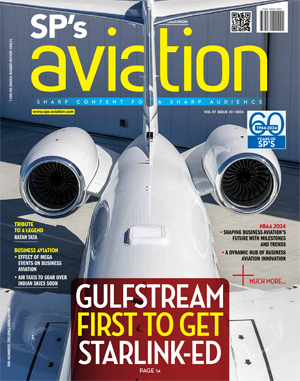INDIAN ARMED FORCES CHIEFS ON OUR RELENTLESS AND FOCUSED PUBLISHING EFFORTS

SP Guide Publications puts forth a well compiled articulation of issues, pursuits and accomplishments of the Indian Army, over the years

"Over the past 60 years, the growth of SP Guide Publications has mirrored the rising stature of Indian Navy. Its well-researched and informative magazines on Defence and Aerospace sector have served to shape an educated opinion of our military personnel, policy makers and the public alike. I wish SP's Publication team continued success, fair winds and following seas in all future endeavour!"

Since, its inception in 1964, SP Guide Publications has consistently demonstrated commitment to high-quality journalism in the aerospace and defence sectors, earning a well-deserved reputation as Asia's largest media house in this domain. I wish SP Guide Publications continued success in its pursuit of excellence.
Has India Missed the Bus?

Inordinate delay in arriving at a decision and failure to join the programme at its inception essentially means design engineers of HAL have in all probability lost out on the opportunity to benefit from the involvement in the concept and design phase
In the wake of a preliminary inter-government agreement for the joint development of the Fifth Generation Fighter Aircraft (FGFA), signed on October 27, 2007, Sukhoi Director Mikhail Pogosyan was quoted as saying, “We (India and Russia) will share the funding, engineering and intellectual property of the new project in a 50-50 proportion.” In the interim five years between the initial proposal in 2002 and the final agreement in 2007, the Russians continued to develop their own version of the Fifth Generation fighter and named it Perspektivnyi Aviatsionnyi Kompleks Frontovi Aviatsy (PAK-FA), Russian for Prospective (Promising) Aircraft Complex (System) of Frontline Aviation.
As stated earlier, the Indian side did not find the T-50 PAK-FA, a single-seat version meant for the Russian Air Force, wholly suitable and instead projected the requirement of a new customised two-seat version based on the T-50 platform for the Indian Air Force (IAF) to conform to some tenets of its operational doctrine and philosophy. A top IAF official confirmed the force’s preference for a twin-seat fighter, observing, “The service prefers a two-seat version for long duration missions to cater for crew fatigue, better crew co-ordination, and so on. However, for short duration missions, a single-seater would suffice.”
At the time of signing the deal in 2007, the Russians had maintained that even though the two-seat configuration necessitated reworking of wing design and control surface for the FGFA, it would be possible to have a test ‘article’ ready for its first flight in early 2010. However, dichotomy in perceptions of the two parties over the design of the new aircraft had to be resolved first. The redesigning of the wings and control surfaces would imply that though patterned on the T-50 PAK-FA, FGFA will be a significantly different aircraft. So far, there is no definite information on the construction of the FGFA prototype. However, Russian Deputy Premier and Defence Minister Sergei B. Ivanov has assured that the FGFA for the IAF is expected to undertake its maiden flight in 2012 and is scheduled to be inducted by 2015. But the IAF’s Chief, Air Chief Marshal P.V. Naik, is somewhat conservative in his estimates. As per his statement to the media, the plan is to induct the FGFA into the IAF in 2017 time frame, an opinion shared by Hindustan Aeronautics Limited (HAL).
But what will be HAL’s role in the design and development of the aircraft? It is a known fact that the T-50 PAKFA has been under development for several years and by now it would be reasonable to assume that the major design parameters would have been finalised. Unfortunately, on account of the inordinate delay in arriving at a decision and failure to join the programme at its inception, design engineers of HAL have in all probability lost out on the opportunity to benefit from the involvement in the concept and design phase. At this late stage, as far as the design work is concerned, the Indian partners would be assigned work peripheral in character, like it happened in the BrahMos project in 1998. Even in the Su-30 project in which India was a partner, it was limited to providing avionics and a few non-critical sub-assemblies.
Earlier this month, it was reported that the Bangalorebased HAL has negotiated firmly to get a 25 per cent share of design and development work in the FGFA programme. According to the report, HAL’s work share will include critical software, including the mission computer; navigation systems; most of the cockpit displays; the countermeasure dispensing systems; and modifying Sukhoi’s single-seat prototype into the twin-seat fighter that the IAF wants. While HAL and other related indigenous industries may be able to provide the software and some of the avionics described above, doubt persists with regard to converting the airframe from single to twin-seat configuration with indigenous design changes. It is felt that this work would have to be undertaken by the Russian designers; who in all probability would design a trainer version of the aircraft for their own use.
However, their trainers are primarily used for training purposes, with limited combat capabilities. The twin-seat trainer version of PAK-FA could be modified to produce the desired two-seater FGFA combat aircraft for the IAF, on the same lines as was done in the case of Su-30 aircraft, which itself was a derivative of the single-seat Su-27 aircraft. This could well be done in the reverse order also, that is, the Russians produce the twin-seat combat aircraft for the IAF first and then modify it into a trainer version to suit their own requirement.





